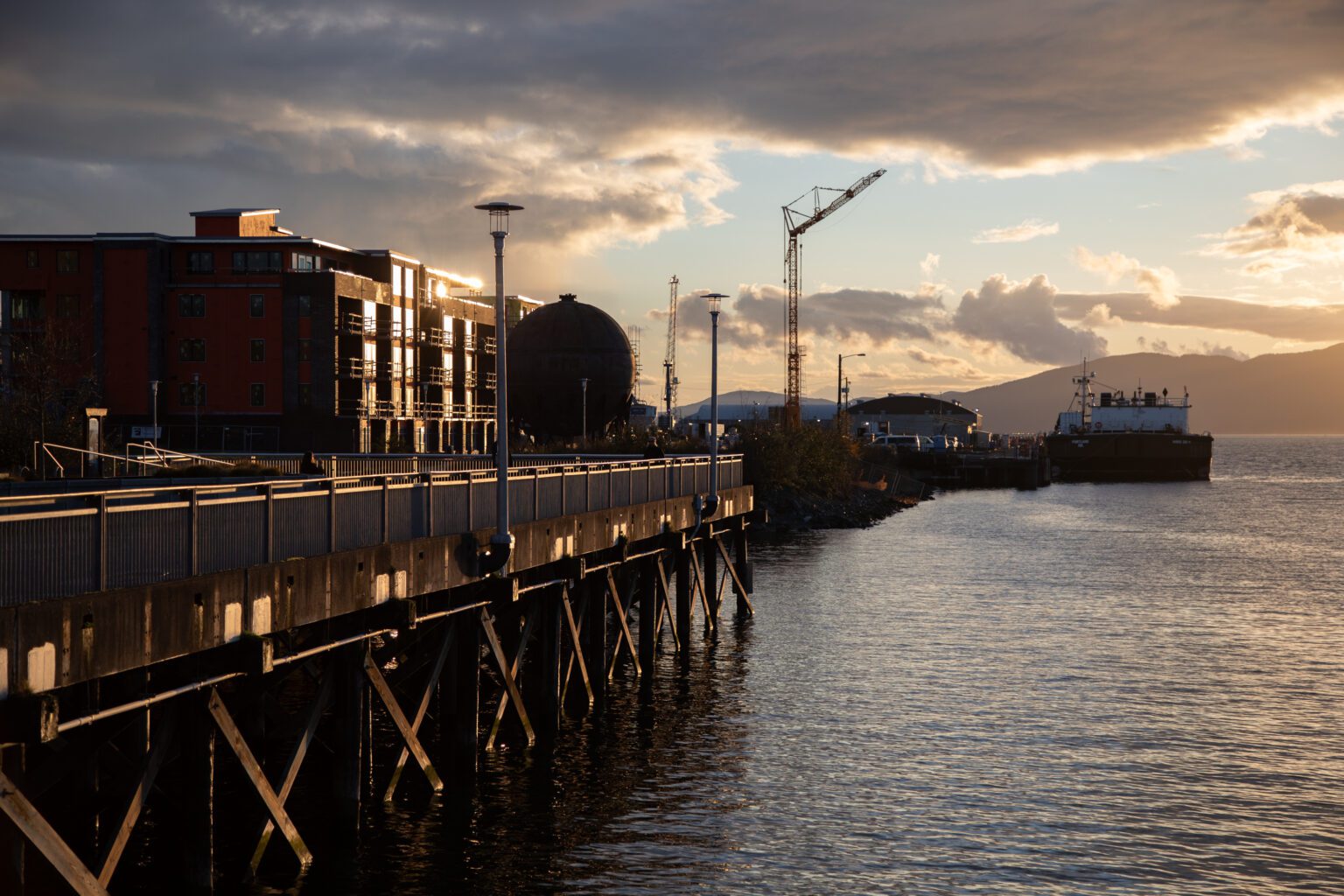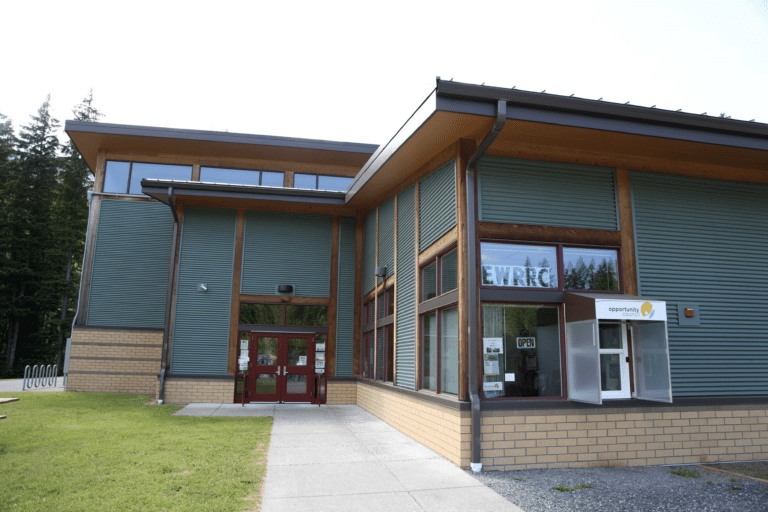Editor’s note: Working Waterfront is a six-part series that captures the past, present and future of Whatcom County’s waterfront, and highlights the people behind the industry. Today’s final story covers current development and what might be next. Find the first five parts here.
More than 20 years after community stakeholders began reimagining Bellingham’s downtown waterfront, it remains mostly a blank slate.
The Port of Bellingham, the government agency overseeing development of the 137-acre former mill site, touts its initial successes on the waterfront and insists the area remains full of promise. But people closely involved in the early planning for the location say a series of missteps by the port has derailed their vision.
This includes the latest high-profile snafus with Harcourt Developments and a recent tenant, ABC Recycling.
The Irish developer’s repeated lapses prompted the port to sue Harcourt on March 14. Originally teed up to be the major player in reshaping Bellingham’s waterfront, Harcourt has since lost most of its development rights on the central waterfront, on land adjacent to its condominium property on Whatcom Waterway. The developer initially secured a Master Development Agreement in 2015 with the port, gaining exclusive rights to develop 18.8 acres of land.
Harcourt’s hiring has long been controversial among city leaders and residents who participated in multiple planning processes for the waterfront property. One called it a devil’s bargain.
This week, the port terminated another agreement, this time with ABC, the Canadian metal-recycling company, less than two years into a 15-year lease. Port commissioners in 2022 had called the move a “tremendous economic opportunity” and a “potential job-creating asset,” but ended the lease because ABC Recycling failed to meet environmental standards.
Some port critics see these pauses as a chance to go back to the drawing board and salvage something of what early planners wanted to see: the transformation of a contaminated industrial site into a centerpiece defining downtown Bellingham’s vibrant and environmentally friendly future.
Kirsten McDade, a close observer of the early waterfront planning who is now north sound waterkeeper for RE Sources, said she would welcome a refresh on the planning process, particularly in the central core of the downtown waterfront, where a bicycle pump track and container village now sit.
“How great would that be, to invite the community back, to have the community have a decision in what happens there,” McDade said. “People love that area as a gathering space, and how can we maintain some of that?”
Given that some development is already underway, Port Commissioner Michael Shepard said this week it would be appropriate “to surgically reopen some of the planning process.”
“If we’re going to revisit a planning process, we need to take this opportunity where we had expected Harcourt to facilitate that … for us,” he said.
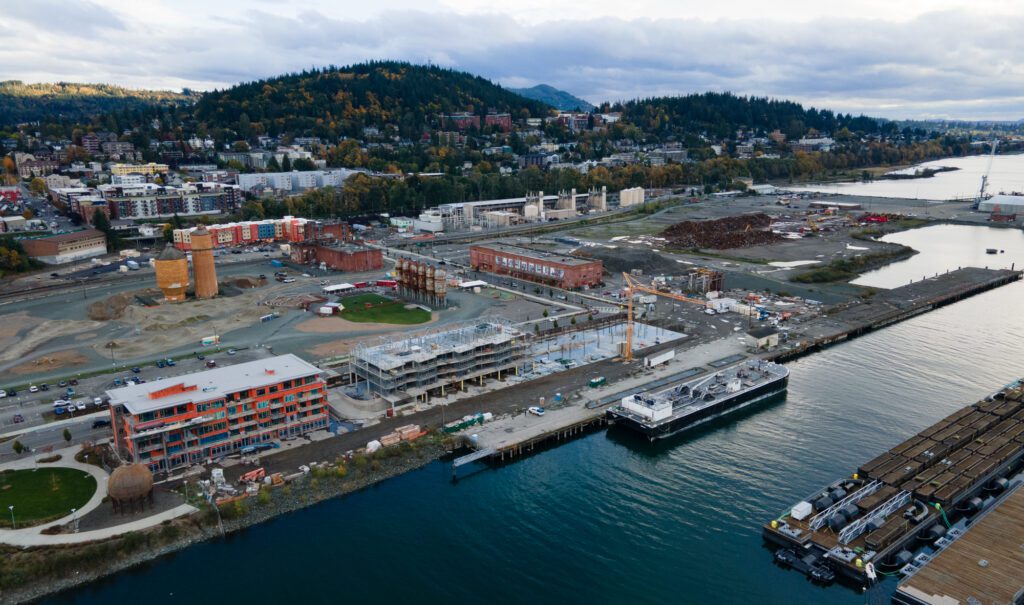
The lay of the land
In 2004, a planning committee called the Waterfront Futures Group came up with what member John Blethen recently called a “very idealistic” plan.
The group was a two-year effort that cost the port and the City of Bellingham $500,000, port Public Affairs Administrator Mike Hogan said. But port and city officials ultimately didn’t want anything to do with its plan, Blethen said.
Recommendations in the Futures Group plan, which encompassed everything from Little Squalicum Beach to Chuckanut Bay, included creating a “sense of place” at each location, encouraging “jobs of the future” and providing a prominent role for the Lummi and Nooksack tribes.
The plan emphasized public open space with plenty of room to create views and accessways to the water. Industry got a nod, too — specifically “fisheries and ocean-related research industries.”
The plan also included public docks along Whatcom Waterway, which would give tourists and local fishermen the opportunity to tie up and come on shore to enjoy Bellingham’s downtown amenities.
As Blethen described the plan’s evolution, it went from the Futures Group to an advisory group that was meant to turn the plan into action.
“The port made sure no one from the waterfront visioning group was allowed to be on the waterfront advisory group,” Blethen said. “By the time it hit the (city) planning commission, it was a different document. And by the time it hit the city council, it was an extremely different document.”
“I think there was a lack of people who had good visioning skills, who took what was a very idealistic document and reduced it to where we are now — which is pathetic, quite frankly,” Blethen added.
Hogan disagreed with this account, saying the port’s plan calls for a balance of environmental, economic and community objectives developed to restore the health of the land and water, and improve waterfront access.
“The [Waterfront Futures Group] Vision and Framework Plan was incredible work, which has since been integrated into the Waterfront District Master Plan to help guide and manage water-related development,” Hogan said.
But George Dyson, a member of the Bellingham Bay Foundation, a now-defunct waterfront activist group, and a close observer of the Futures Group, pointed to a number of outcomes that contradicted the early plan.
This would include Harcourt Development’s two five-story condominium buildings along Whatcom Waterway.
The Futures Group suggested that development be “layered in,” with taller buildings set back from the water, and ample room for parks left along the water’s edge.
“It’s a devaluation of the space to plop the condos right on the edge,” Dyson said.
He added that the port erred when it sold the condominium properties and the nearby Granary site to Harcourt. The Futures Group called for keeping the waterfront in public ownership, to ensure public benefit.
“It was public land, and we sold it to this foreign developer for nothing,” Dyson said, referring to the 1.733-acre strip where the condominiums are going up.
An internal port memo from April 2018 confirms that the port sold the strip along Whatcom Waterway to Harcourt for $1.6 million, or merely $21.22 per square foot.
Dyson insists the waterway needs public docks, another proposal from the 2004 Futures Group plan and a prominent feature on Port Townsend’s waterfront. The Port of Bellingham’s current proposal does call for public moorage, but Dyson is skeptical.
“I’ll believe it when I see it,” Dyson said. “They keep saying that, but that stuff takes so long to permit and plan.”
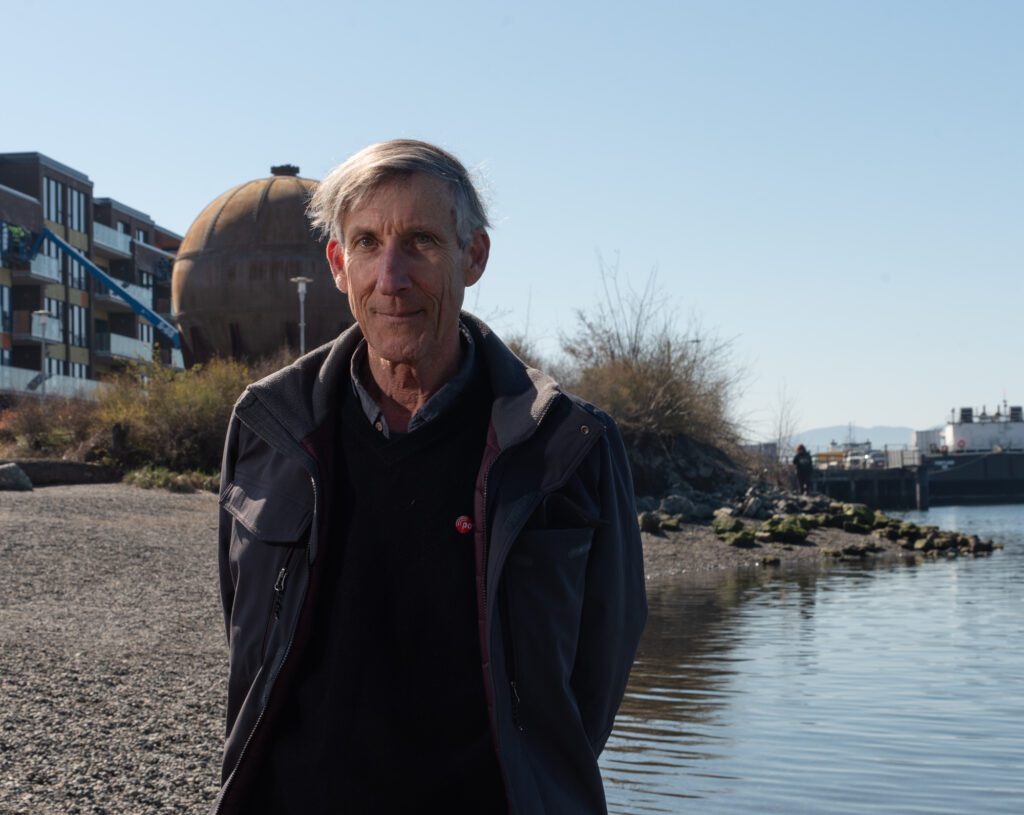
In the city’s parlance, the waterfront district is an urban village, the same category used to describe Fairhaven, Samish Way, Barkley and other high-growth pockets around Bellingham. Urban villages are intended as places of rapid commercial and residential growth.
As such, the district plan calls for 5.3 million square feet of total building space, whether commercial, residential, office, institutional or industrial. What this will look like will depend on what future developers propose for the vacant sites, and which ideas get chosen by port commissioners.
By that measure, waterfront development is 1% complete. All that’s finished is Harcourt’s Granary building, with about 50,000 square feet of office and commercial spaces. The building is fully leased, except for 1,700-square-feet on the ground floor and a rooftop space, said Christopher Erdmann, CEO and co-owner of blu.ink Real Estate.
Progress on the condos next to the Whatcom Waterway has been slow. Harcourt originally anticipated finishing them in 2019. A third building is still little more than a bare foundation, where construction has stalled for months.
The first building, closest to Waypoint Park, should open by July, Erdmann said. About 85% of the units were reserved as of late March, according to the condominium website, with price points ranging from about $500,000 to the $1.75 million penthouse.
“I have high confidence that all three get built,” port Executive Director Rob Fix said. Harcourt has financial incentive to get its return on an expensive investment in the parking garage built under the condos, and the developer’s financial lender will require follow-through, Fix said.
Harcourt officials did not respond to multiple requests for comment.
Harcourt’s stumbles
Those who watch the progress on the downtown waterfront have reason to be skeptical about Harcourt’s commitment to Bellingham.
Initially granted rights to develop 18.8 acres on the northeast end of the former Georgia-Pacific site, Harcourt missed construction deadlines on two condominium buildings in 2021 and had its share of the waterfront reduced to 7.7 acres. Harcourt blamed delays on COVID-19 shutdowns.
The agreement was rewritten in 2021, giving Harcourt until October 2023 to complete the first two buildings. After missing that deadline, Harcourt lost the right to develop 5.3 acres between Granary Avenue and the pump track.
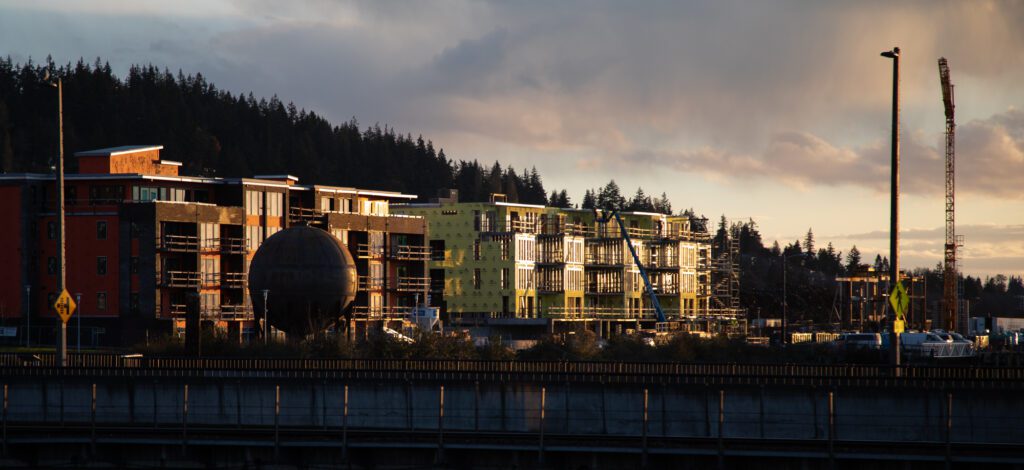
It was quite the fall for Harcourt.
Now, all the developer will finish — if it finishes — is the row of condominiums.
“What was so disappointing about that is, we watched them be successful in Liverpool. We watched them be successful in Belfast. We watched them be successful in Dublin,” Fix said. “They just did not bring their capital to Bellingham, Washington, like they said they were going to.”
Harcourt is challenging the Port’s decision to rescind the company’s remaining development rights.
For now, Harcourt hasn’t gone so far as to sue the port for terminating the agreement. But Harcourt has a litigious history, having been involved in lawsuits in Nevada and Dublin, as well as in Jersey, in the English Channel.
Waterfront critics insist the port should have known better than to sign with a foreign company out of touch with Bellingham’s values.
Dyson recalled an early community meeting with Harcourt, when someone asked how the developer would make room for fishing boats. The Harcourt representative’s response, Dyson said, was not received well.
“He said, ‘The day of the fisherman is over,’” Dyson recalled. “You don’t say that in Bellingham. It’s still a fishing town. Not like it used to be, but it’s not over.”
Other developments on the horizon
Some other progress has been evident on the central waterfront property.
Millworks, an affordable housing project at Cornwall Avenue and West Laurel Street, was expected to open in April to families making 50% to 60% of the area median income. Rents will range from $872 to $1,459 a month. A few units are set aside for “extremely low-income folks” coming out of homelessness, Environmental Planning Director Brian Gouran told the port commission on Jan. 23.
“It is something we all should be really proud of,” Gouran said.
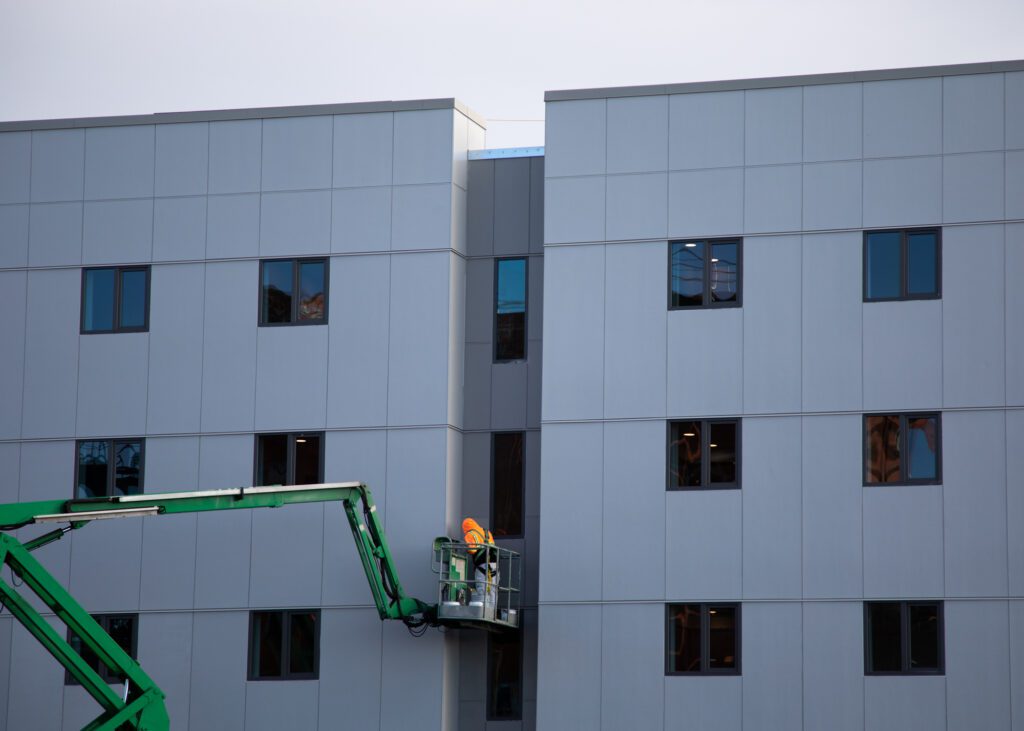
Local developers also are repurposing the old Boardmill building, adding a boutique hotel, residences and a parking garage with a rooftop park. The latest version of the plan includes a 107-room hotel and about 240 new residences.
The project is in design review and permitting and won’t break ground for roughly 18 months, said Michael Watters, part of the BoardMill Group development team.
So far, the developer and the port, as property owner, are getting along better than the waterfront’s expelled master developer.
“When we won (the bidding for the Boardmill project), we looked the city in the eye and the port in the eye and said we want to genuinely partner with you and come up with something that is incredible, something that is incredibly Bellingham,” Watters said.
For now, some of the most popular features at the waterfront aren’t permanent: a bicycle pump track and a container village that includes Kulshan Trackside Brewery with a large outdoor space that bustles in the warmer months. The pump track is in an area designated as park space, and it won’t necessarily need to move.

The city for now has only granted temporary permits to the container village, but it also could stay in place, Commissioner Shepard said, especially if the nearby historic Alcohol Plant building is converted into something like an indoor food court, so the village can become a year-round attraction.
Across the Whatcom Waterway at what the port calls the marine trades area — home to All American Marine and similar businesses — port commissioners will consider a proposal to fill in about half the enclosed 30-acre treatment lagoon, known as the aerated stabilization basin, or ASB. If commissioners approve, that work could happen next year in conjunction with cleanup of the ASB. The fill would add an estimated 14 to 17 acres of new, developable land on the waterfront.
“A huge percentage of our community is employed in the marine-trades industry, so the fact that we can add 14 acres of land to that inventory is big,” Fix said. A 2016 study showed that “roughly 7% of the Whatcom County workforce” is employed in the marine trades.

The port is discussing with Lummi Nation a possible future ‘presence’ for the tribe in the marine trades area, and also possibly the downtown waterfront area where G-P once stood. Fix said port officials met with tribal leaders on March 21 to discuss ideas — although nothing was decided.
“We very much want them down there, and they want to be down there,” Fix said.
Despite repeated requests, Lummi Nation officials declined to comment.
A place for industry
Industrial use has always been a part of Bellingham’s waterfront, but ideas differ about what appropriate industry looks like.
Corvus Energy, with its 40 new high-tech jobs, opened with much fanfare on the Fairhaven waterfront in January 2023 — worthy of a visit from Gov. Jay Inslee.
The Norway-based company produces sustainable energy storage systems for marine vessels.
“Any time a governor can celebrate a new company that has no big smoke stacks coming out of it … that’s joyous,” Inslee said at the time.
Contrast that with ABC Recycling, which had been loading ships with scrap metal — and polluting the water running off its work area, as suggested by stormwater samples with high levels of pollutants taken at the shipping terminal during ABC’s time there.
Critics of the waterfront plan, including Bellingham City Council member Lisa Anderson, said ABC Recycling was never a good fit.
“This isn’t what we intended,” Anderson said at a Dec. 11 council meeting, before ABC lost its lease. “I’ve had hundreds of conversations with individuals about the waterfront, and what they bought into and envisioned in a working waterfront was manufacturing, … supporting our marine trades and green-industry jobs and, you know, the future.”
Port representatives, including Commissioner Ken Bell, countered that ABC Recycling was a proper fit for the waterfront all along.
“That scrap steel was the first commodity that came to the table was unfortunate because it is ugly and it is loud, but it is well within the parameters of what a shipping terminal should be used for,” Bell said.
Bellingham Mayor Kim Lund is still a newcomer among those who will directly guide the waterfront’s future — especially its connections to downtown. She acknowledged a tension between the port’s mandate to grow the economy and community members’ visions for an accessible, environmentally-friendly gathering place.
“We have a number of significant projects underway all along the Bellingham Bay shoreline that are in alignment with the community’s vision to provide more public spaces and increased access to experience our waterfront,” Lund said, citing the development of the new Salish Landing Park at the former Cornwall landfill, and the Boardmill hotel and housing project.
Port critics welcomed the idea of reviving waterfront planning in the spirit of the early Futures Group. Dyson, for one, said that particular group should be revived.
Early planners advocated for a signature waterfront park that would serve as a gateway to the San Juan Islands and include cultural centers celebrating the Coast Salish People, with a presence for NOAA (National Oceanic and Atmospheric Administration) and Western Washington University.
NOAA in 2011 moved 175 jobs and a large marine infrastructure from Seattle’s Lake Union to Newport, Oregon, a move that port critics still see as a major missed opportunity for Bellingham’s waterfront. Western abandoned its own plans to be a player in waterfront redevelopment in February 2022, citing a lack of consensus about what to build there.
Blethen said a new phase of planning should focus on how the shipping terminal might operate in a way that harmonizes better with the parks, residences and other more attractive waterfront functions.
“That’s one area that could certainly be altered, if we had a port that was interested in seeing a world-class development on the waterfront,” he said.
Fix said the waterfront plan “was always anticipated to change over time,” given the extended timeline of buildout. This is especially true now that Harcourt has been denied its remaining development rights.
Would the port go so far as to reconvene something on the scale of the Waterfront Futures Group? Commissioner Shepard didn’t rule it out.
“There has been some time that has passed since the initial planning period,” he said. With Harcourt out of the picture, he added, “we have a new opportunity for the port and the public to have a greater level of control and visioning for what that looks like.”
Ralph Schwartz is CDN’s local government reporter; reach him at ralphschwartz@cascadiadaily.com; 360-922-3090 ext. 107.

